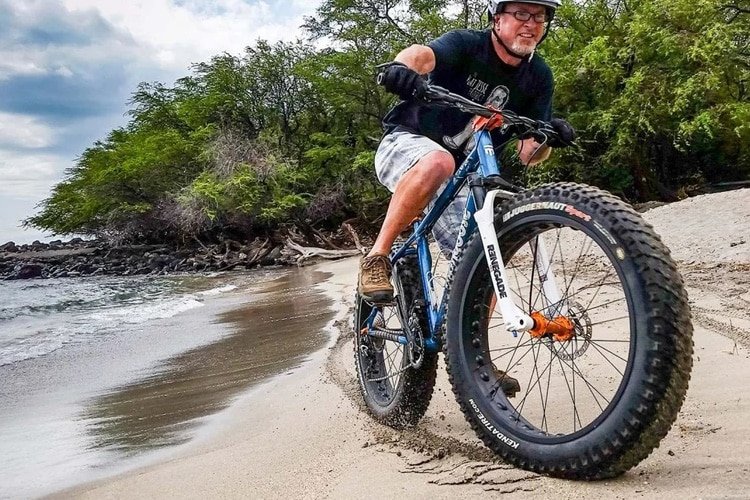A few years ago, fat bike bicycles went from being complete strangers to one of the strongest fashions in the world of mountain biking. Do you know what they are and their advantages?
At the moment this trend has lost steam but it has not stopped having followers, since these bikes seem to have found their place among different types of buyers. Since I have never prepared a specific post for fat bikes before, today I would like to explain what they are, what characteristics they have and what advantages or disadvantages they present compared to other types of bikes.
What are fat bikes and what are they for?

In essence, fat bikes are bicycles specifically designed to circulate on terrain that requires special traction, as happens in desert and snow conditions (due to sand and snow). For this they use particularly wide tires: between 3.8 and 5 inches approximately (for this reason they should not be confused with “plus” bikes whose width does not usually exceed 3 inches) that can have particularly low pressures.
Particularly with its eruption in the market, there were many brands including the electric ones like Himiway fat tire electric bike that tried to give a much more general use to these bikes than the one mentioned by me in the previous paragraph, which led to a polarization in the opinions of different users (since the opinion The public was divided between staunch followers and detractors of this trend), since there were already several types of bicycles that, except for aesthetics, would fulfill the same task as these fat bikes.
Advantages of the fat bike

They have the ability to roll on terrain much more easily such as sandy areas, snow or ice. In this way they present an extreme grip for areas in which, as a general rule, one could not stay on the bike.
They are one of the most stable bikes on the market. Their wheel width allows them to pass obstacles and descend with great ease, making inexperienced runners able to run more safely.
Precisely this stability, together with the ball of the tire (which in circumference resembles the size of 29 ″, despite the fact that the wheels of fat bikes are usually 26 ″) and their weight, make them a great droppers on the market. (In addition to being very fun to wear).
By being able to carry the tires with very low pressures, a lot of comfort is gained, making the bicycle not always have to carry a suspension fork.
Points against fat bikes

They are especially heavy bicycles. This, coupled with the fact that they have so much traction, means that in asphalt, flat and uphill areas, a lot of ballast is carried and it is difficult to move the bike.
Related to the previous point, it should be noted that they are not agile and especially manageable bikes (especially compared to other alternatives on the market).
Due to the two previous points, in the face of conventional use (trail, somewhat XC rides) they are very physically demanding.
The price of their covers and cameras can exceed double compared to traditional ones. This factor must be valued daily in a purchase on a whim.
Fat bikes opinions
As you may have seen, versatility is not something that has stood out at any point, because depending on how you see it, it can be a point for or against. Everything will depend on the cyclist’s fitness, the use he wants to give it and the circuits he wants to run on.
Really for trails and roads, a trail or XC bike will do better than a fat bike and on very steep descents, there are models such as enduro or DH that are better designed for it. For this reason, for my taste, these bicycles continue to fulfill a more specific function, such as allowing the cyclist to circulate on snow and sand, more difficult and inhospitable terrain for other models.
Aesthetics, I would have included it as a plus point but that is very subjective, despite the fact that it has been one of the great keys to its success in recent years.
Types of fat bikes

We could divide fat bikes into three different main categories, based on the number of suspensions they incorporate:
Completely rigid. They are those in which the front fork does not have any special damping system. They are really the ones that are best prepared for snow or sand, since in neither of these situations a suspension fork is required, at the same time they present fewer mechanical problems.
With front suspension. They are those bikes that have a front fork with suspension. They are more designed for trail and XC use, although they are still very versatile.
Double suspension. They are those that have front fork with suspension and rear shock absorber. They are the most focused on a use of all kinds (XC, trail, descent, etc.), although it moves away from the original sense of the design of fatbikes.
Apart from this we can see fat bikes that may vary depending on:
Your material. Like most models today, you can see that the frames can be made of carbon, aluminum, steel, or titanium. Basically, a fat bike has relatively the same material as an electric moped bike, for example.
The number of dishes in your transmission. They currently work with the three main types: single, biplate and triplate.
The breaks. In the vast majority of cases they are hydraulic, although there are also mechanical ones.
These last three points only make the range and price range in which the fat bike moves vary.
This summer, with all its advantages, riding a fat bike can be an option. You can explore difficult tracks without having to worry about slipping. Fat tires ensure that your bike keeps tread stably even though you are working on rocky tracks.




